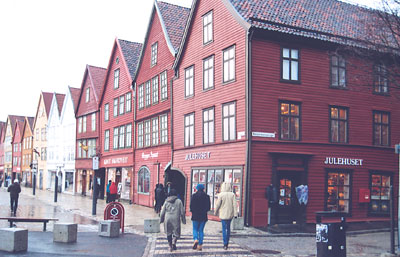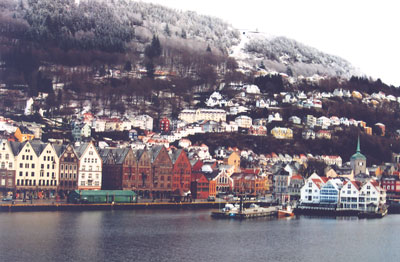Bergen: Hanseatic city
This item appears on page 58 of the October 2012 issue.
In its time, Bergen was one of the most important cities of Northern Europe. Founded in 1070 by King Olav Kyrre on the western coast of Norway, Bergen served briefly as the country’s capital from 1217 to 1299 before the capital was moved to Oslo.
Its importance was also directly related to its growth as a trading center, especially after 1350, when it became one of the principal foreign trading posts of the Hanseatic League.
Hanseatic League
The Hanseatic League was a confederation of Northern European cities formed for mutual security and to ensure exclusive trading rights for its members.
The league’s center was in the city of Lübeck in northern Germany. It also included Köln, Gdansk, Bremen, Hamburg, Riga and Tallinn and, in its heyday at the end of the 14th century, as many as 150 other cities.
The league lasted until 1669, when a combination of the growth of Dutch and English shipping, the development of new trade routes, internal dissension and the rise of national European states spelled its demise. But, until then, the league was immensely powerful.
In addition to the member Hanseatic cities, a constantly varying number, there were four principal foreign trade centers called kontors. Bergen was one of these along with London, Bruges and Novgorod.
Fish (especially dried cod), fish oil, salt and hides from Norway were traded for grain, fur, timber and amber from the eastern Hanseatic cities.
Bergen’s trading quarter was centered on an area along the harbor called the Bryggen, consisting of the quay and the area immediately behind it. There German merchants worked and lived in wooden buildings that served as their warehouses, trade offices and living quarters.
Only remaining Hanseatic city
Bergen is unique. It is the only one of the many Hanseatic cities to have preserved so much of its Hanseatic past. In all, the Bryggen area of Bergen has more than 60 intact structures, now part of the UNESCO World Heritage. To walk there is to walk into the Middle Ages.
Perhaps the best places to get a sense of Bergen’s Hanseatic past are two outstanding museums, the Bryggen Museum and the Hanseatic Museum, both located in the Bryggen.
The Bryggen Museum displays finds from recent on-site archaeological excavations plus the foundations of several medieval houses, some as old as 800 years, while the Hanseatic Museum was once a merchant’s home and workplace.
An hour spent in each will give a good idea of life during Bergen’s Hanseatic days, roughly between the 14th and 18th centuries.
Strolling through Bryggen
After the museums, it’s time for a stroll among the Hanseatic buildings lining the wharf and the area behind it.
Long rows of tall buildings with gables face each other across long, dark, narrow passageways. Thread your way down these passageways that once led to warehouses and offices on ground floors with living quarters located on upper floors. The passageways now lead to shops and restaurants.
One of the oldest buildings, St. Mary’s Church, is located just outside the warehouse area. Dating from the 12th century, the church is in the process of being restored and is closed to the public until 2015. To view two of its highlights — the pulpit and the altar — you’ll have to go online for the next few years.
Royal Bergen
Just a 10-minute stroll from the Bryggen is the area called the Holmen in the Middle Ages and now Bergenhus Festning (Bergen Castle). This is where the Norwegian kings lived.
What remains are the 13th-century Rosenkrantz Tower, a combined fortress/residence; the 13th-century Haakon’s Hall, once a royal residence and administrative center, and the Commandant’s Residence, built in 1725 on top of the stone foundation of a medieval building. The castle complex is dramatically lit at night.
Also don’t miss…
If the only place you visit in Bergen is the Bryggen, you will have seen a lot, but Bergen has much more to offer.
Among the “must sees” are the harborside area around the Fish Market; a series of art museums lining Rasmus Meyers allé, by the lake in the center of the city; the Akvariet (Aquarium), home to sharks, seals and penguins; the funicular up Mount Fløyen, for a panoramic view of city, mountains and fjords; Troldhaugen, the home of Norway’s most famous composer, Edvard Grieg, and the 12th-century Fantoft stave church.
The last two are short excursions outside of central Bergen. There are also half-day and full-day fjord excursions one can do out of Bergen. One of these, at least, should be added to any Bergen trip, especially if you’re not cruising up the Norwegian coast.
If you go…
On the visit to Bergen that my husband and I made in January/February 2012, we stayed at the Clarion Hotel Admiral (phone 47 55 23 6400, e-mail cl. admiral@choice.no), on the harbor at C. Sundts gate. Its location is the best in Bergen, with a spectacular view of the Bryggen and the Bergenhus Festning across the harbor. The hotel is a 10-minute walk from the Fish Market and 20 minutes from the Bryggen.
Rooms are comfortable, and the breakfast buffet is bountiful. A nice touch is complimentary tea or coffee with cookies every afternoon in the lobby bar.
Rates for rooms range from NOK980 (near $166) to NOK2,295 ($388). A seaview room will cost NOK200 ($34) extra but is well worth it, especially at night when the Bryggen buildings are lit. Check the Internet for special offers.
The Bergen Card offers free or discounted admission to certain museums, sightseeing tours, restaurants and entertainment in the city. Cards cost NOK200 ($36) for 24 hours or NOK260 ($46) for 48 hours. The card can be purchased online at www.visitbergen.com/Bergenskortet and picked up at the Tourist Information Office at the Fish Market on arrival in Bergen.
The Tourist Information Office publishes an excellent booklet, “Bryggen: World Heritage City,” available free. It details a point-to-point walking tour of the Bryggen and the Bergenhus areas.


